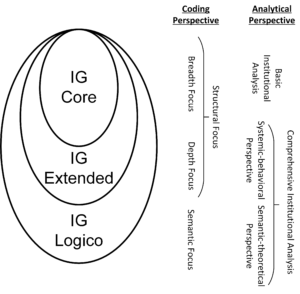Institutional Grammar 2.0
The Institutional Grammar 2.0 (IG 2.0) is a specification that builds on the original Institutional Grammar (IG) concept proposed by Crawford and Ostrom (1995; 2005), and is a collaborative effort between Saba Siddiki (Syracuse University, NY) and myself. The Institutional Grammar, devised in the context of political science (and more broadly applied in the context of policy studies), is an analytical tool that operates on so-called institutional statements that capture behavioural expectations (“regulate behaviour”), and more recently in IG 2.0, descriptions of institutional settings (“parameterize systems”), as expressed in natural language. The IG does so by systematically breaking those down in an accessible syntactic form that allows for the representation of strategies (or conventions), norms, and rules as found in policy texts, or in human behaviour more generally. Since the adoption of the IG for systematic policy coding, the “Grammar” has experienced selected refinements that respond to limitations for the use in different application areas (e.g., Siddiki et al., 2011; Frantz et al., 2013), and, amongst other innovations, motivate the development of a refined institutional grammar specification, IG 2.0.
Overview of IG 2.0
The IG 2.0 offers a refined version of the institutional grammar that has the following objectives:
- Resolve ontological inconsistencies in the original institutional grammar
- Establish comprehensive and reliable coding of institutional statements as they occur in policy
- Afford computational tractability to enable novel analytical uses within and across different disciplines
To accommodate a broad set of use cases, analytical objectives as well as techniques as relevant for different disciplines, the IG 2.0 introduces refined coding of institutional statements on three levels of expressiveness that show an incremental increase in complexity: an initial layer that focuses on coarse structural encoding (IG Core) and is largely equivalent to the coding of the original institutional grammar. It further features an advanced layer that facilitates deep structural coding (IG Extended). To facilitate the coding of structure, IG 2.0 makes extensive use of nested institutional statements (see here for details on the underlying principles). The final layer emphasizes the semantic perspective (IG Logico) by making logical relationships explicit and offering enhanced semantic annotations that enable logical operations on encoded statements. The figure below schematically visualizes these levels and their corresponding focus.

As part of this, IG 2.0 refines the original grammar syntax by differentiating between context that reflects the precondition for the activation of a given statement (activation conditions), and context that qualifies the application of a statement (execution constraints), resolving essential ontological inconsistencies that arise from the conflated understanding of both.
Affording a more comprehensive coding, IG 2.0 further introduces a novel constitutive syntax that sits alongside the revised regulative syntax of the institutional grammar. Doing so, institutional statements can now be encoded irrespective of their regulating function (i.e., behavioural expectations) or their parameterizing function (i.e., defining entities, such as actors, roles, objects in institutional settings).
Capturing the ontological refinements that resolve ambiguities in coding, extending the comprehensiveness, and making the coded statements more readily parse-able for computational purposes, the IG opens up novel analytical opportunities in diverse domains, including policy studies, but further extending to institutional modelling using agent-based simulation, as well as the logical treatment of legal documents, e.g., to make those accessible for the purpose of algorithmic governance.
Resources
Following this brief conceptual overview, below you find links to essential and supplementary resources specific to IG 2.0:
Note that this page will evolve over time since IG 2.0 is under active development and evaluation. Resources that offer a substantive theoretical treatment of the underlying concepts will be linked here once they appear.
- Institutional Grammar: Foundations and Applications for Institutional Analysis – Book providing a comprehensive overview of Crawford and Ostrom’s Institutional Grammar, relevant applications over time, as well as providing a comprehensive conceptual introduction of the Institutional Grammar 2.0, including a detailed discussion of levels of expressiveness. It further introduces a novel encoding syntax (IG Script) to facilitate encoding of institutional information. Finally, the book highlights novel analytical opportunities associated with the IG 2.0 (e.g., systemic analyses, behavioral and complexity studies), before discussing directions for further development. The book has a dedicated companion website under newinstitutionalgrammar.org.
- Institutional Grammar 2.0: A Specification for Encoding and Analyzing Institutional Design – Article introducing the IG 2.0 and discussing the motivation, underlying conceptual principles, including levels of expressiveness, statement types (regulative, constitutive, hybrid), as well as pointers towards analytical opportunities.
- Institutional Grammar 2.0 Codebook – A central operational guide for the coding according to IG 2.0 is the codebook and the development of studies using IG 2.0. It includes a primer on essential underlying concepts, as well as additional information such as pre-processing guidelines, but most importantly, the comprehensive instructions on how to code all features available in IG 2.0. However, note that the codebook is tool-agnostic, and thus does not promote a specific form of encoding, such as tabular systems, text annotation tools, etc.
Encoding & Analytical Tools
- IG Parser – Facilitates the encoding of institutional statements in the IG Script syntax using the to facilitate data collection for further analysis with the Institutional Grammar 2.0.
- IG-Inception Annotation Layers – To support the encoding of institutional statements using web-based annotation tools, we provide experimental annotation layers for the open-source text annotation tool Inception.